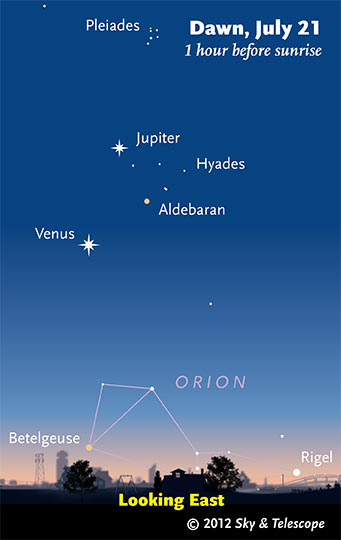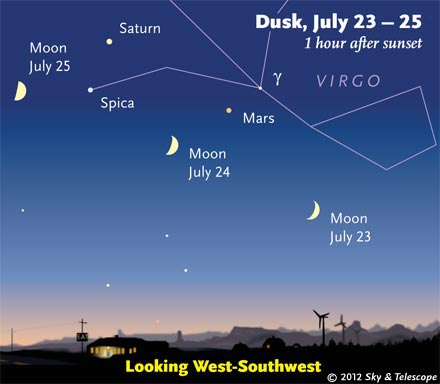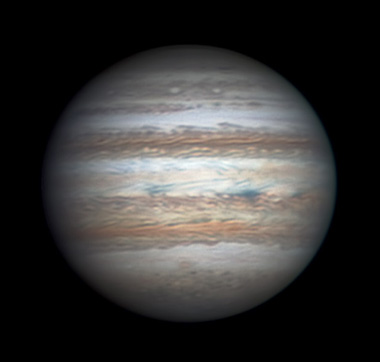
Venus and Jupiter gradually move farther apart as they climb higher in the dawn.
Sky & Telescope diagram
Friday, July 20
Saturday, July 21
Sunday, July 22
Monday, July 23

Watch the Moon wax thicker from night to night as it steps past Mars, Saturn, and Spica. (These scenes are drawn for the middle of North America. European observers: move each Moon symbol a quarter of the way toward the one for the previous date. The Moon is shown three times actual size.)
Sky & Telescope diagram
Tues. July 24
Wed. July 25
Thurs. July 26
Friday, July 27
Saturday, July 28
Want to become a better amateur astronomer? Learn your way around the constellations. They're the key to locating everything fainter and deeper to hunt with binoculars or a telescope.
For an easy-to-use constellation guide covering the whole evening sky, use the big monthly map in the center of each issue of Sky & Telescope, the essential magazine of astronomy. Or download our free Getting Started in Astronomy booklet (which only has bimonthly maps).

The Pocket Sky Atlas plots 30,796 stars to magnitude 7.6 — which may sound like a lot, but that's less than one star in an entire telescopic field of view, on average. By comparison, Sky Atlas 2000.0 plots 81,312 stars to magnitude 8.5, typically one or two stars per telescopic field. Both atlases include many hundreds of deep-sky targets — galaxies, star clusters, and nebulae — to hunt among the stars.
Sky & Telescope
Once you get a telescope, to put it to good use you'll need a detailed, large-scale sky atlas (set of charts). The standards are the little Pocket Sky Atlas, which shows stars to magnitude 7.6; the larger and deeper Sky Atlas 2000.0 (stars to magnitude 8.5); and the even larger Uranometria 2000.0 (stars to magnitude 9.75). And read how to use sky charts effectively.
You'll also want a good deep-sky guidebook, such as Sue French's Deep-Sky Wonders collection (which includes its own charts), Sky Atlas 2000.0 Companion by Strong and Sinnott, the bigger Night Sky Observer's Guide by Kepple and Sanner, or the classic if dated Burnham's Celestial Handbook.
Can a computerized telescope replace charts? I don't think so — not for beginners, anyway, and especially not on mounts and tripods that are less than top-quality mechanically (able to point with better than 0.2° repeatability). As Terence Dickinson and Alan Dyer say in their invaluable Backyard Astronomer's Guide, "A full appreciation of the universe cannot come without developing the skills to find things in the sky and understanding how the sky works. This knowledge comes only by spending time under the stars with star maps in hand."
This Week's Planet Roundup

Jupiter's North and South Equatorial Belts have swapped appearances since last year! South here is up. The South Equatorial Belt (above center)has turned narrow and dark, while the North Equatorial Belt has turned paler and very broad, the opposite of how they used to appear. Christopher Go in the Philippines took this superb image on July 11th with a 14-inch telescope in, he says, “perfect seeing.”
Mercury is out of sight in conjunction with the Sun.
Venus and Jupiter (magnitudes –4.6 and –2.1) shine dramatically in the east before and during dawn. They've widened to about 10° or 12° apart now, with Jupiter higher. Look for Aldebaran, much fainter, below or lower right of Jupiter. Also in Jupiter's starry background are the Hyades, and above it are the Pleiades.
The asteroids Ceres and Vesta, magnitudes 9.1 and 8.4, are in the area too! See article Predawn Treats for Early Risers for the naked-eye aspect, and to find the asteroids, Ceres and Vesta: July 2012 – April 2013.
Mars (magnitude +1.0, in Virgo) glows orange low in the west-southwest at dusk, lower right of the Saturn-and-Spica pair by about 13°. It's heading their way; Mars will pass between Saturn and Spica in mid-August. In a telescope Mars is gibbous and very tiny, 6 arcseconds wide.
Saturn (magnitude +0.8, in Virgo) shines in the southwest as the stars come out. Below it by 4½° is Spica, nearly the same brightness but twinklier. After dark they move lower to the west-southwest.
Uranus (magnitude 5.8, at the Pisces-Cetus border) and Neptune (magnitude 7.8, in Aquarius) are high in the southern sky before the first light of dawn. Finder charts for Uranus and Neptune.
All descriptions that relate to your horizon — including the words up, down, right, and left — are written for the world's mid-northern latitudes. Descriptions that also depend on longitude (mainly Moon positions) are for North America. Eastern Daylight Time (EDT) equals Universal Time (also known as UT, UTC, or GMT) minus 4 hours.
Like This Week's Sky at a Glance? Watch our weekly SkyWeek TV short. It's also playing on PBS!
To be sure to get the current Sky at a Glance, bookmark this URL:
http://SkyandTelescope.com/observing/ataglance?1=1
If pictures fail to load, refresh the page. If they still fail to load, change the 1 at the end of the URL to any other character and try again.
 0
0
Comments
You must be logged in to post a comment.